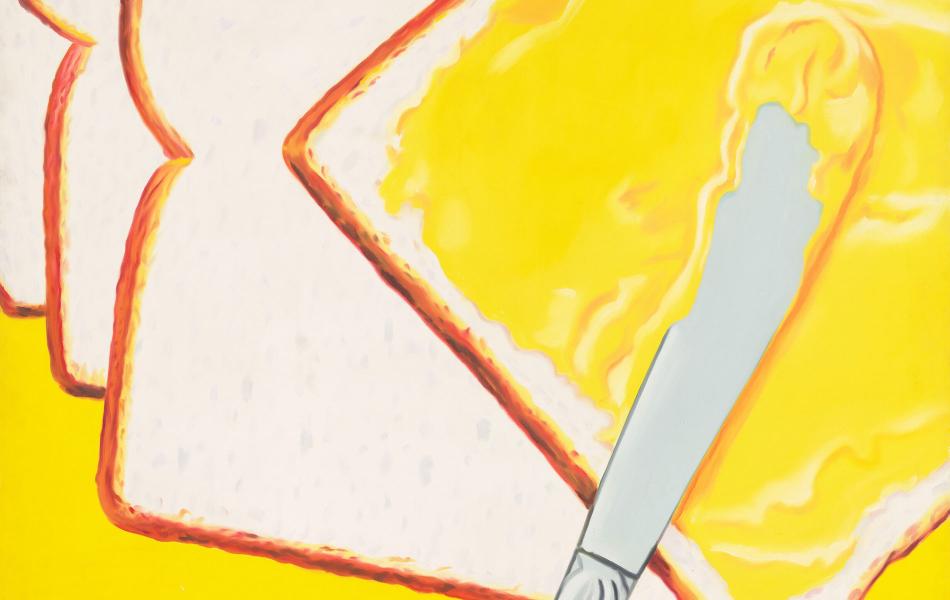A Dessert
1814
Raphaelle Peale
Painter, American, 1774 - 1825

As the oldest son of Charles Willson Peale, Raphaelle Peale was the first in a dynasty of painters and botanists burdened by the names of famous artists and scientists that their father admired. In the first history of American art, published nine years after Raphaelle Peale's death and one of the very few notices taken of him, William Dunlap wrote that Peale, like his father, was "a painter of portraits in oil and miniature, but excelled more in compositions of still life. He may perhaps be considered the first in point of time who adopted this branch of painting in America." [1] Dunlap was absolutely right about the excellence of Raphaelle's still lifes and, as far as we can tell, about his being America's first still-life painter. What Dunlap did not see as clearly was that Raphaelle Peale was one of the most gifted artists in America at the turn of the nineteenth century, and one of its most daring, for he chose still life at a time when that subject was held in low esteem.
Raphaelle Peale did not have a happy or a tranquil life. He lived in uncertain times of revolution, war, profound social and political change, and rapidly shifting values and tastes. Given the name of the greatest artist of modern times, Raphaelle Peale was freighted with an unbearable standard of perfection. His marriage was unhappy, he was irresponsible as a parent, and he was chronically unsuccessful as an artist. By his thirties his hands and legs were crippled by gout. He was so seriously ill from alcoholism that he was committed for "delirium," and from its effects he died at the age of fifty-one.
None of this is seen or felt in the technical refinement, classic order, and serene beauty of his still lifes, least of all in what is surely his greatest and most perfect one, A Dessert.
(Text by Nicolai Cikovsky Jr., published in the National Gallery of Art exhibition catalogue, Art for the Nation, 2000)
Notes
1. William Dunlap, History of the Rise and Progress of the Arts of Design in the United States, 3 vols. (New York, 1834), 2:51.

West Building Main Floor, Gallery 69-A
Artwork overview
-
Medium
oil on wood
-
Credit Line
Gift of Jo Ann and Julian Ganz, Jr. in memory of Franklin D. Murphy
-
Dimensions
overall: 34 x 48.3 cm (13 3/8 x 19 in.)
framed: 53 x 67 cm (20 7/8 x 26 3/8 in.) -
Accession Number
1999.44.1
More About this Artwork

Article: Food Art Favorites to Feast Your Eyes On
Feast your eyes on our top 10 favorite food paintings at the National Gallery and download your favorites for free. See still lifes and pop art by Paul Cézanne, James Rosenquist, Robert Seldon Duncanson, and more.
Artwork history & notes
Provenance
James Fullerton, Boston, by 1818 until at least 1828. Oswald J. Arnold [1873-1949], Chicago and Minneapolis; by inheritance to his sister, Charlotte A. Arnold, Minneapolis; her nephew and his wife; purchased 1975 by (Terry Delapp, Los Angeles); purchased 1976 by Jo Ann and Julian Ganz, Jr., Los Angeles;[1] gift (partial and promised) 1999 to NGA; gift completed 2008.
[1] Provenance from curator's acquisition proposal and catalogue of the 1981 exhibition of the Ganz collection (An American Perspective). James Fullerton lent the painting to the Boston Athenaeum's annual exhibition in 1828.
Associated Names
Exhibition History
1828
Second Exhibition of Paintings, Athenaeum Gallery, Boston, 1828, no. 151, as A Desert [sic].
1949
Loan to display with permanent collection, Minneapolis Institute of Arts, 1949-1951.
1981
An American Perspective: Nineteenth and Twentieth Century Art from the Collection of Jo Ann and Julian Ganz, Jr., National Gallery of Art, Washington, D.C.; Amon Carter Museum of Western Art, Fort Worth; Los Angeles County Museum of Art, 1981-1982, no. 77, repro.
1988
Raphaelle Peale Still Lifes, National Gallery of Art, Washington, D.C.; Pennsylvania Academy of the Fine Arts, Philadelphia, 1988-1989, no. 2, repro., as A Dessert [Still Life with Lemons and Oranges].
2000
Art for the Nation: Collecting for a New Century, National Gallery of Art, Washington, D.C., 2000-2001, unnumbered catalogue, repro., as A Dessert (Still Life with Lemons and Oranges).
Bibliography
2004
Hand, John Oliver. National Gallery of Art: Master Paintings from the Collection. Washington and New York, 2004: 330-331, no. 266, color repro.
2025
" American and British Paintings for the Nation: An Interview with Franklyn Kelly." Art for the Nation 70 (Summer 2025): 14, fig. 12.
Inscriptions
lower right: Raphaelle Peale Aug:-5th 1814 / Philad:; reverse: Fullerton
Wikidata ID
Q20183499

